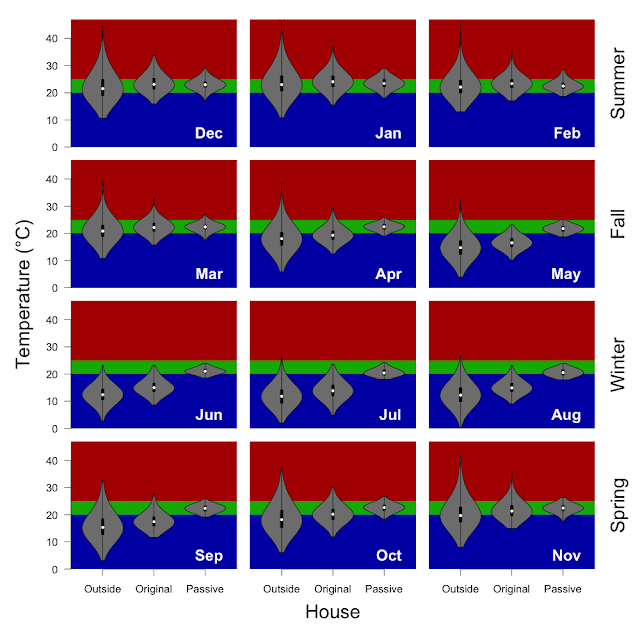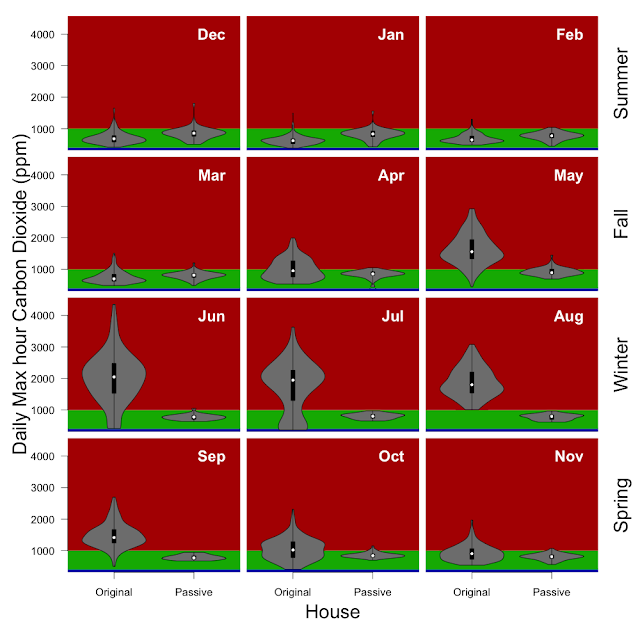November 2019 summary
Another month in the house, and we are getting a lot better with managing the night ventilation... The 4% of hours that were less than 20 °C were all associated with excessive cooling of the house over night prior to hot days. In the house the highest hourly temperature (26.2 °C) was recorded in the northwest bedroom, and the lowest hourly temperature (18.3 °C) was recorded in the Study. Outside the highest hourly temperature was 38.7 °C, and the lowest hourly temperature was 7.9 °C.
At no point in November was the A/C used.
Starting on November 20th we started logging the HRV system in collaboration with Zehnder (the maker of our Zehnder ComfoAir Q 350) and FanTech (the Australian supplier of the unit). Sydney is a borderline situation where it is not clear which type of system is better. So they are interested in comparing Heat Recovery Ventilation (HRV, only heat is recovered) with Energy Recovery ventilation (ERV, where heat and moisture are both recovered). The unit used for HRV and ERV are exactly the same - the exchange core is swappable. At the moment we are recorded all of the HRV parameters every 5 minutes...
Methods: I have taken the 5 minutely data from the wirelessTag sensors and calculated the median temperature of each sensor for each hour and determined the proportion of hours falling inside of the 20 - 25 °C target temperature (using the R functions 'aggregate' and 'hist'). Inside includes data from 12 wirelessTag sensors spread across every room of the house. Outside is the data from the wirelessTag sensors in the cubby house, outside, and HRV intake. The water wall and door data are not included.
At no point in November was the A/C used.
Starting on November 20th we started logging the HRV system in collaboration with Zehnder (the maker of our Zehnder ComfoAir Q 350) and FanTech (the Australian supplier of the unit). Sydney is a borderline situation where it is not clear which type of system is better. So they are interested in comparing Heat Recovery Ventilation (HRV, only heat is recovered) with Energy Recovery ventilation (ERV, where heat and moisture are both recovered). The unit used for HRV and ERV are exactly the same - the exchange core is swappable. At the moment we are recorded all of the HRV parameters every 5 minutes...
| Inside / Outside | % < 20 °C | % 20 - 25 °C | % > 25 °C |
|---|---|---|---|
| Inside | 4.3 | 94.3 | 1.4 |
| Outside | 55.7 | 24.3 | 21.0 |
Methods: I have taken the 5 minutely data from the wirelessTag sensors and calculated the median temperature of each sensor for each hour and determined the proportion of hours falling inside of the 20 - 25 °C target temperature (using the R functions 'aggregate' and 'hist'). Inside includes data from 12 wirelessTag sensors spread across every room of the house. Outside is the data from the wirelessTag sensors in the cubby house, outside, and HRV intake. The water wall and door data are not included.


